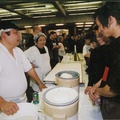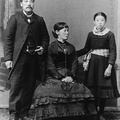Part 1 >>
Second World War
The relatively tranquil life of the Japanese in Oregon came to an abrupt halt with Japan’s attack on Pearl Harbor on December 7, 1941. That very afternoon, the FBI initiated a roundup of Issei community leaders. Iwao Oyama, the publisher of Oshu Nippo, was working on Monday’s issue when the FBI agents came to his office in Japantown and arrested him. A few days later the FBI agents arrested the proprietor of Teikoku Shoten, around the corner from Oshu Nippo. Later the federal officials confiscated Oshu Nippo’s printing press that was never returned to Oyama or his family.

World War II: Teikoku Company with Evacuation Sale sign in the window, NW 3rd and Davis Street, Portland, Oregon, 1942. Courtesy of Matsushima Family, Oregon Nikkei Endowment
On January 30, 1942 Portland City Council rescinded all business licenses issued to Japanese residents. On February 19, 1942, President Franklin Delano Roosevelt signed Executive Order 9066.
Notices were posted on April 28, 1942 ordering Japanese Americans living in Portland area and South Central Washington to report to Portland Assembly Center by noon, Tuesday, May 5, 1942. Portland’s Pacific Northwest Livestock Exposition Pavilion used for cattle, horses, and hogs, was converted into a temporary detention center for almost 4,000 people. Starting in late August and into September 1942, Japanese Americans were transferred by railroad trains to desert concentration camps at Minidoka, near Twin Falls, Idaho; Heart Mountain, Wyoming; and Tule Lake, California. Most spent three long years living in tarpaper barracks. Patrolling soldiers were ordered to shoot anyone who stepped beyond the barbed wire boundaries.

World War II: Construction of living quarters for Portland Assembly Center at the Pacific International Livestock Exposition Pavilion, 1942. National Archives.
Resistance
In Oregon, Minoru Yasui, a young Nisei attorney in Portland challenged the wartime curfew imposed on Japanese residents by walking the streets of Portland. When patrol officers did not pay any attention to him, he walked into the police station to inform the authorities that he was in violation of the curfew and should be arrested. He was convicted of violating curfew and served nine months in solitary confinement in Multnomah County jail before being sent to a desert prison camp. The appeals to his conviction were denied. In 1983, his case was reopened upon discovery that the government had withheld critical evidence. Minoru Yasui died before his case could be retried.

World War II: Nisei soldiers Bob Ando, Morey Okita, Menow Hara, Jim Onchi, & Kaz Hinatsu. Courtesy of Joe Onchi, Oregon Nikkei Endowment.
Military Service, Questions of Loyalty
Japanese Americans served in the First World War, and prior to the Japanese attack on Pearl Harbor, they joined the military like any other American. Nisei soldiers already serving in the army were discharged or reassigned to nonessential positions. In 1943, the U.S. Military changed draft classification for men of Japanese descent from 1-A (Fit for Service) to 4-C (Enemy Alien). Later, as the Second World War progressed, the United States reversed its position, and Japanese Americans became eligible to serve. Oregon Nisei solders were among members of 442nd Regimental Combat Team and the Military Intelligence Service. One Oregon Nisei volunteered to serve in the Air Force and met all qualifications, but when he reported for induction he was told that the Air Force did not accept Japanese.
© 2006 Oregon Nikkei Endowment





